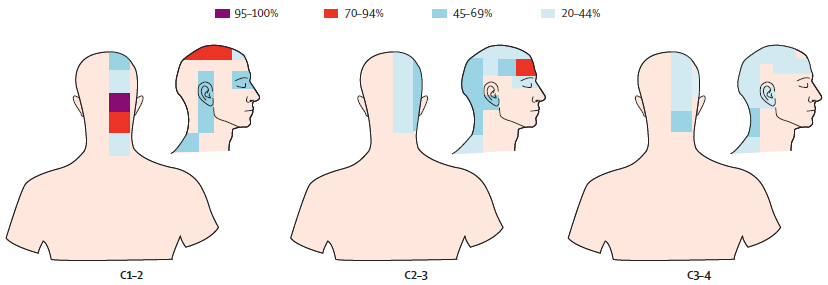NECK-RELATED HEADACHES: HOW CAN I STOP THIS?
Key Points Related To Headaches:
- 70% of people with frequent intermittent headache report neck symptoms associated with their headache (1)
- Cervicogenic Headache is the name of the diagnosis where pain is felt in the head but being referred from a primary source in the cervical spine (neck) (2)
- PAIN IN THE FRONT OF THE HEAD: the nerves that supply the forehead and region of the eyes (orbital region) and the nerves that supply the cervical spine (neck) have what is effectively like a “meeting point” called the trigeminocervical nucleus (or TCN).
- Irritation of the cervical nerves (due to various factors such as awkward sustained postures, trauma, lack of muscle endurance for example) send messages to the TCN and thus messages can then get sent around the forehead and orbit region with a subsequent pain response felt at various parts of the head (as seen in the below picture; (2)).

5. A key research study looking at participants aged 18 to 60 with cervicogenic headache symptoms were randomly allocated to one of three groups (3);
- Exercise therapy: addressing the deep cervical muscles with what’s considered ‘low load’ as opposed to heavy strengthening. In addition, some of the muscles near to the shoulder blades were trained.
- Manual therapy: “hands on” techniques to the cervical spine to help alleviate symptoms
- A third group received a combination of both manual therapy and exercise therapy.
- The results revealed both manual therapy (“hands on”) and exercise therapy, used alone and in combination, were effective in reducing headache frequency and intensity, neck pain and disability and medication use and maintained for a 12 month period.
See in the below video 1 of the exercises as performed in the study by Gwen Jull and others with the aim to help decrease headache symptoms.
1. Zito, G., Jull, G., & Story, I. (2006). Clinical tests of musculoskeletal dysfunction in the diagnosis of cervicogenic headache. Manual therapy, 11(2), 118-129.
2. Bogduk, N., & Govind, J. (2009). Cervicogenic headache: an assessment of the evidence on clinical diagnosis, invasive tests, and treatment. The Lancet Neurology, 8(10), 959-968.
3. Jull, G., Trott, P., Potter, H., Zito, G., Niere, K., Shirley, D., … & Richardson, C. (2002). A randomized controlled trial of exercise and manipulative therapy for cervicogenic headache. Spine, 27(17), 1835-1843


